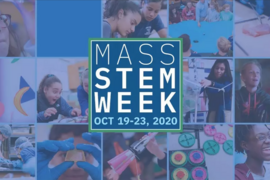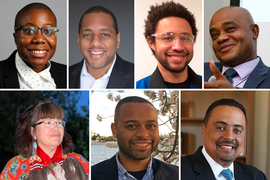Valencia Joyner Koomson ’98, MNG ’99 was recently appointed as Visiting MLK Scholar in MIT’s Department of Electrical Engineering and Computer Science. Based at Tufts University, where she is an associate professor in the Department of Electrical and Computer Engineering, Koomson has focused her research on microelectronic systems for cell analysis and biomedical applications. Here, she shares more about her work and the future of her field.
Q: What big question does your research seek to answer? Put another way, what set of problems are you most interested in solving?
A: I’m interested in how we can make electrical systems into useful forms that improve people’s lives, from portable sensors and wearable devices that allow people to monitor their health outside the clinical setting, to miniaturized systems that measure communications between growing cells.
Q: Why is this problem particularly important to solve — what kinds of real-world applications does this work have?
A: One application area I started in was in neonatal care: How do we monitor the health of very fragile lives, such as preterm infants? Over a million babies per year are born in the United States preterm (which is defined as below 38 weeks). Globally, there are nearly 15 million children born too early. Being born prematurely can introduce a number of health considerations, specifically neurological damage due to low levels of oxygen reaching brain tissues. Many times, neurological damage can only be detected by MRI, and when you’re dealing with a tiny one-pound baby, having them undergo an MRI scan is usually not possible. So we are developing an imaging tool that works much the same way as a pulse oximeter, using near-infrared spectroscopy. In short, you would shine a light at different wavelengths on the baby’s forehead and study the propagation of light through tissue to monitor brain oxygenation — a crucial vital sign. This is a more advanced implementation of the same near-infrared spectroscopy techniques which are already being used in the Fitbit, in Apple watches, and in the health care setting to measure arterial oxygen saturation.
Q: Tell us a little about your daily routine within the lab. What does a typical day look like for you as a research scientist?
A: One of the crucial parameters we have to measure is how light is absorbed and scattered in tissue. To accomplish that, we build silicon tissue “phantoms” in both solid and liquid forms, which are crucial before we go to human validation studies. All the theory we use is based on photon diffusion and propagation through tissue. The silicone is a simplification; our bodies are very complex, but we model them as one single material.
Additionally, we build optoelectronic systems that are miniaturized to test how well the circuitry is working. Those microsystems are built using large, commercially available foundries, using industry-standard processing technology, but we also have software tools that allow us to model the physics and electrical characteristics of our device and simulate how it will work once it is fabricated.
Obviously, we do a lot of optical and electrical validation as well to make sure our system is functional before we test it with a human or any other test.
Q: How did you first develop an interest in this line of inquiry? Has your area of interest shifted over time?
A: My interest in microelectronics began as an undergraduate at MIT, taking course 6.374 (Introduction to VLSI Design), which at the time was taught by Anantha Chandrakasan, and conducting research with Tayo Akinwande in [Microsystems Technology Laboratories]. The faculty were at the forefront, designing low-power electronics for digital and mobile computing. I was exposed to a lot of cutting-edge research, which got me thinking about the potential of microscale electronics to make people’s lives better.
Then, while working in the Tufts Department of Biomedical Engineering, I had a colleague studying how we model photon diffusion in tissue. They use large commercial instruments to do these measurements, but my colleague observed that it would be great if we could measure how the O2 measurements changed in patients with neurological damage while they were doing an activity. To accomplish this, we would need a lightweight, portable measuring device, not a benchtop piece of equipment that weighs 35-40 pounds. So that’s where we got starting thinking about miniaturization; next, we started thinking about monitoring tissue oxygenation in the [neonatal intensive care unit] incubator at the point of care.
Q: When you look into the future of your field, what excites you the most?
A: There are huge opportunities in the field of health monitoring. This pandemic has highlighted the need for people to monitor their own vital signs (like oxygen saturation) and get clinical-grade data accurately at home. Using machine learning and data-driven approaches to assist disease diagnosis would have a widespread appeal, not only here in the U.S., but in the developing world where many patients don’t have access to large, sophisticated instruments like those found at a hospital bedside in the United States.
So our question becomes: how do we build portable, inexpensive instruments that can work in low- and middle-income countries and in the home? For example, what if we want to reduce readmission rates after heart surgery (as my colleagues and I wanted to do at Beth Israel)? Can we detect arrhythmias at home, once patients return to their normal daily activities? And can we build systems that allow us to predict acute cardiac events, find atrial fibrillations, etc? That project led to larger thinking about health monitoring outside the cardiac ward, for instance in the developing world. I have collaborators at the University of Ghana and we are working on a proposal to form an interdisciplinary center to harness health data science research, mobile devices and [mobile health (mHealth)] technology to develop solutions to pressing public health challenges. Mobile phone technology has good penetration there, so it’s a good test market for mHealth research.
Q: Let’s talk a little about the social side of science. Many students of color and women worry that the STEM field won’t welcome them — and those fears have foundations. When you look at the landscape for scientists of color, especially women, what do you see right now? Are there signs of progress?
A: I see a lot of great opportunities opening up. Throughout the Covid pandemic, I’ve become even more keenly aware of the groups forming around women of color in AI, robotics, and other fields. People are using their own initiative to get on LinkedIn and other social media platforms with other like-minded people to talk, have a virtual seminar, write grants, and share resources together. There has been an opening of doors in terms of helping people to connect and collaborate within their field and across fields. Right now, all the academic hot topics are cross-disciplinary, so if you’re in a field without a lot of women (and especially women of color) like electrical engineering, you’ll be collaborating with people in biology, computer science, etc. That cross-disciplinary conversation widens your net quite broadly, just as social media has expanded our means of collaborating. I collaborate with scientists in Ghana and advise students there, just as I would with a student in the United States.
Furthermore, since the pandemic began and conferences began switching to virtual platforms, I’ve had the chance to participate in three conferences I don’t usually get to go to, as a woman with two small kids and limited ability to travel. And I’m seeing that phenomenon play out in those conferences. The American Society of Engineering Education had a panel about increasing diversity in education; a normal conference might have 40-50 people in attendance; now that it’s virtual, there were 300 attending. I participated in a virtual robotics workshop during Black Women in AI Week with engineers from three continents. So, people are getting engaged in a way they haven’t before.









